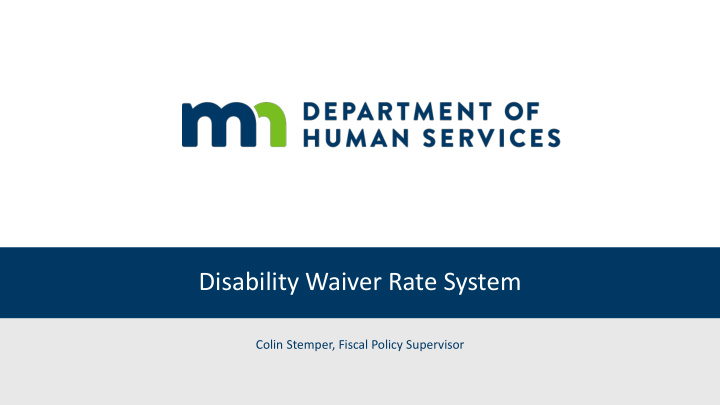



Disability Waiver Rate System Colin Stemper, Fiscal Policy Supervisor
DWRS background • In 2007, CMS informed Minnesota that its county-negotiated rates for the disability waivers did not comply with federal requirements. • CMS required Minnesota to have a uniform rate determination method and standards. • The 2013 Minnesota Legislature passed the Disability Waiver Rate System (DWRS) to meet this requirement. • This legislation created the rate frameworks and banding schedule. • DHS began implementing DWRS in January 2014. 5/3/2019 2
DWRS background • DWRS is Minnesota’s rate-setting method for DD, CADI, CAC and BI waiver services. • Under DWRS, each service has a specific way a rate is established: • Framework rates • Pre-determined rates • Market rates • People often refer to framework rates when they talk about DWRS. 5/3/2019 3
Framework rate services • Adult day services • ILS • Customized living services • Individualized home supports • DT&H/Structured day program • Night Supervision • Employment services • Personal support/adult companion • Foster care/supported living • Prevocational services • Housing access coordination • Respite (15- min) • In-home family support 5/3/2019 4
What are rate frameworks? • Lead agencies use the frameworks to determine rates through provider- informed inputs. • Inputs are referred to as “component values.” • Frameworks are loaded into RMS in MnSP, which lead agencies use for actual rate calculation. • Component values are set in Minnesota Law (256B.4914). • DHS has conducted extensive research to determine costs of providing disability waiver services to inform the component values. 5/3/2019 5
DWRS banding • People who do not have framework rates have banded rates. • Banded rates are tied to pre-DWRS rates in 2013, in order to facilitate a transition to the rate frameworks. • People may have banded rates in the following cases: • The person received the same service, from the same provider, in December 2013. Called an “individual historic rate.” • The day or unit-based service provider provided the same service in a particular county in December 2013. Referred to as a “weighted average.” • The person received a residential service in December 2013, but has since switched providers/services. Called a “residential change in service.” 5/3/2019 6
DWRS banding schedule • Minnesota law sets the duration of the banding period (256B.4913): • 2014: 0.5 percent from historic rate • 2015: 0.5 percent from 2014 rate • 2016: 1 percent from 2015 rate • 2017: 0.5 percent from 2016 rate • 2018: 1 percent from 2017 rate • 2019: 0 percent from 2018 rate 5/3/2019 7
What happens after banding? • Following the banding period, in 2020, all framework services will have rates determined by the frameworks. • The December 2018 DWRS Semi-Annual Report estimates the overall impact to banded rates: Service Category Projected change in service rates, post-banding Day services 3.3% increase Residential services 14.8% increase Unit-based with programming services 38.4% increase Unit-based with programming services 11.3% increase Overall 14.1% increase 5/3/2019 8
What are rate exceptions? • A decade of research has shown that the rate frameworks cover the costs of services for most people receiving waiver services. • However, some people may have support needs that require costs far in excess of what is covered by the frameworks. In order to cover these extraordinary costs, the lead agency and DHS must approve a rate exception. • Rate exceptions must be based on a person’s extraordinary support needs and reflect service costs borne by the provider. 5/3/2019 9
How do rate exceptions work? • Rate exceptions still use the DWRS frameworks for a service. Except, instead of the statutory cost components, higher values are used to reflect the extraordinary costs of serving a person. • Example: The DWRS direct care wage component for foster care is $13.53. But the person’s complex behaviors require staff with more experience. These more experienced staff must be compensated at a $17.50 wage. • In this example, $17.50 would replace $13.53 in the rate framework – all the other cost components may stay the same. 5/3/2019 10
Rate exception limitations • Rate exceptions may not be appropriate in all circumstances. • Generally, a person with a banded service rate is not eligible for a rate exception. • Once banding ends in 2020, this will no longer be a limitation. • Costs that are unrelated to a person’s needs are not eligible for rate exceptions. 5/3/2019 11
Rate exception process • Conversation between the provider, person, family, and lead agency: • Does the person have extraordinary needs? Are those needs documented in the assessment? Is an exception necessary to support the person’s extraordinary needs? • If the lead agency supports the request, it submits a request and support documentation to DHS using the 5820 Exception Request Application. • DHS reviews the request and sends the decision back to the lead agency, which notifies the other parties. • If approved, the rate exception is then authorized. 5/3/2019 12
There are many exception resources available • Instructions to complete the 5820 • Tools to identify specific cost components needing adjustment: • For residential services; and • Day/Unit-based services • Rate exceptions frequently asked questions webpage • Rate exception CBSM page 5/3/2019 13
Thank you! 5/3/2019 14
Recommend
More recommend